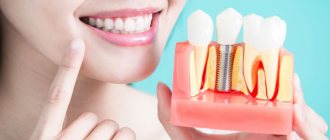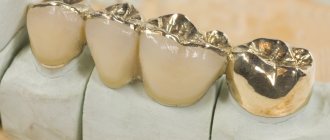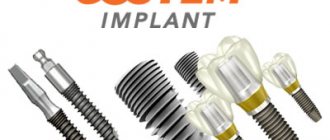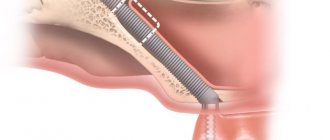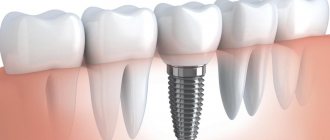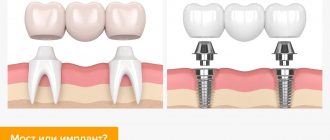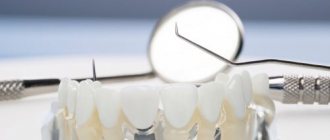The absence of 2 teeth in a row is a common defect that often occurs in patients. The problem needs to be eliminated, because the bone will atrophy, and over time it will be more difficult to solve it. Implantation is considered the best way to restore several teeth in a row, since it is the installation of durable artificial roots that will last a lifetime. On top they are covered with crowns, which completely preserve the function of chewing and recreate the aesthetics of a smile. The choice of implantation method depends on how long ago the teeth were removed and the structural features of the patient’s jaw.
Is it possible to implant 2 teeth at once?
Implanting 2 teeth is no different from restoring one tooth. Artificial roots are also placed, which are then covered with crowns. It is better to install both units at once, without dividing them by time. This will reduce the preparation time, there will be no repeated anesthesia and double antibiotic therapy, which is undesirable to carry out more than once every six months.
Implantation is usually performed using the classical method:
- Installation of an artificial root and prosthetics are separated by 2-6 months, which are needed for the implants to heal.
- First, an implant is placed, the gum is sutured, and fusion occurs with the bone tissue.
- After 2-6 months, the gum is cut, an abutment is placed, and the implant is covered with a crown.
During osseointegration, a removable temporary butterfly immediate prosthesis is worn.
Stages of treatment
1. Consultation
Examination, questioning, selection of treatment protocol.
2. Diagnostics and preparation
Comprehensive examination (orthopantomogram, CT), testing. Treatment of teeth and gums (if necessary), hygienic cleaning, 3D planning of surgery.
3. Implant installation
Carried out in accordance with the selected protocol. In a two-stage procedure, titanium roots are implanted using a patchwork method; in a one-stage procedure, titanium roots are implanted through a micropuncture of the gum or into the socket of an extracted tooth.
4. Prosthetics
Delayed loading with a prosthesis during classical implantation (a permanent orthopedic system is installed on artificial roots after they have completely engrafted). Immediate loading with a one-stage method (on days 1-3, adaptation crowns or a prosthesis made from the patient’s casts are installed on the abutments. After 10-12 months, re-prosthetics are performed with a permanent structure).
The one-step protocol includes one more stage - surgical removal of the affected tooth or root.
Implantation of two teeth side by side
Depending on the location of two missing teeth in a row, the requirements for implants and crowns differ.
Front teeth
When installing implants in the frontal area, there are features:
- increased demands are placed on aesthetics;
- Individual zirconium abutments are used;
- if necessary, gum plastic surgery is performed;
- narrow implants are installed for a narrow frontal area;
- before the implants heal, temporary or lightweight crowns or butterfly prostheses are placed, which are attached to adjacent teeth;
- After engraftment, metal-free zirconium dioxide crowns are installed with the color most closely matched to the shade of adjacent teeth.
Chewing teeth
If there are no two teeth in a row in the lateral zone, thin short implants are not suitable for restoring such units. Wider ones are used so that they can cope with chewing loads. We use durable crowns; we install metal-free ones made of zirconium. Such prostheses last for 20 years and are fully compatible with the body. Immediate loading of the implant with crowns is not permissible, since artificial roots that have not taken root may move during chewing.
Treatment and implantation of two teeth
Attending doctor
Strigin Vladimir Igorevich
Find out the price
Which models are suitable
Knowing the survival rate, statistics of complications after operations, and shelf life, you can calculate the rating of implants. The success of osseointegration depends on the characteristics of the body, the ability of tissues to regenerate, and the experience and responsibility of the dentist. Even the most expensive implants in the hands of an inexperienced doctor can cause complications.
The list of the most reliable implantation systems includes:
- Nobel Bioca - expensive high quality designs with a lifetime guarantee. The model range includes different types of implants that can be used for any clinical situation. The conical artificial root has a double thread, a special type of connection. Nobel Biocare implants have good osseointegration.
- The Swiss company Straumann also provides a lifetime warranty. The implants are of high quality and have good survival rate.
- Astra Tech (Sweden) - known for their high level of quality and stability.
- XIVE (Germany) - have a unique thread, which ensures good stability. Suitable even for spongy bone.
- French Anthogyr designs are made from high quality titanium. Resistant to external influences.
For two anterior teeth
There are high requirements for anterior implants, so they must be selected with the utmost care. They should be:
- small diameter and sufficient length for atraumatic installation;
- equipped with fine threads in the upper part and large threads in the lower part for stability;
- made of zirconium dioxide so as not to show through the gums.
Correct selection of an implant allows you to preserve as much bone tissue as possible and prevent its loss. For the smile zone, one-stage implantation is used with the installation of temporary crowns or a prosthesis on the day of implant installation.
What is placed in the chewing area
In the lateral sections of the jaw, rods that are not as thin as for the front ones are used. The size is selected taking into account the anatomical features and the width of the spaces between the teeth. More often, classical implantation is chosen, which is carried out in two stages. The implant must be able to withstand any chewing load. Crowns or dentures must match the shade and shape of the patient's healthy teeth.
Dental manufacturers offer a varied selection of implants for premolars and molars.
Is it possible to place one implant on two teeth?
This is impossible, since when installing one implant with two crowns, one of them will be suspended. This will create a natural lever that will eventually dislodge the artificial root from the bone. If the dental units are small and located close to each other, there is the option of installing two mini-implants. This way the load will be distributed evenly, but this option is temporary.
Theoretically, there are possible options that we do not practice:
- If there is no central and lateral incisor in the upper jaw, then you can place one implant in the center and hang a small lateral tooth on it. This will reduce the load.
- If there are no two incisors on the lower jaw, then you can make one implant and place 2 crowns with minimal load.
- You can install one implant and place a bridge supported by it and a living tooth. But this is strictly not recommended. Living teeth are mobile, and artificial roots are firmly attached to the bone - a shock-absorbing effect will occur, which will lead to loosening of the prosthesis, dislocation of one or both supports.
Why do we often recommend installing double crowns together rather than separately?
The nature of the functioning of natural teeth
Let's look at what happens to teeth throughout life. Each tooth lives its own life. The teeth are not rigidly fixed in the jaw, but have a small, normally microscopic, physiological mobility, which compensates (absorbs) the load during chewing.
Also, when chewing, in addition to the pressure of the teeth on each other, natural abrasion of the teeth by antagonists occurs, that is, the teeth of the upper jaw are rubbed against the teeth of the lower jaw. Thanks to physiological mobility, the teeth can move slightly from their original position on the jaw and, as it were, adjust to each other for ideal closure when chewing. After all, they were a little worn out, and the relief of their chewing surface became different, and if they were motionless and remained in the same position as before the abrasion, the contacts between the upper and lower teeth would be much worse, and the food would be rubbed worse by them.
In addition to antagonist teeth, the tooth interacts with neighboring teeth. The contact of a tooth with neighboring teeth, also called the “contact point between teeth,” has a very complex shape. After such a shift, it is not broken, a gap does not form between the teeth, and food does not get stuck between the teeth. And this is the most important point to pay attention to.
Features of the functioning of teeth with crowns
What happens to a tooth after an artificial crown is installed on it? The material from which the crown is made is tougher than a natural tooth. The crown is practically not subject to abrasion when chewing. And your teeth without crowns continue to wear out. And the adjustment of the teeth to ideal closure with the help of shifting continues. In a tooth with a crown, this shift, due to the lack of the physiological process of abrasion, is slightly greater than in a natural tooth. And since, no matter how hard the dentist and dental technician try, even using all modern technologies, it is impossible to reproduce on an artificial crown the shape of the contact point, as on a natural tooth with 100% accuracy, then due to the shift of the tooth with the crown, a gap will form between adjacent teeth.
Development of a gap between the crowns, food solidification, bleeding, bad breath with two separate crowns next to each other
If there is a tooth without a crown next to the crown, this process will be slow and may not bother the person, because one of the teeth has a natural, “correct” contact point. But if there is the same artificial crown nearby, then the resulting gap can become a problem. At first it’s not big: sometimes food gets stuck, which causes a little pain and a little bleeding from the gums. Then the problem grows, food gets stuck constantly, after eating the gums and teeth ache, bleeds at the slightest touch, it becomes more and more difficult to clean this place, and a pathological periodontal pocket forms. This place hurts almost constantly, and there is bad breath. All this is aggravated by the fact that the materials from which crowns are made are smoother than natural teeth, and food slips between them more easily. And over time, these symptoms increase and increase. In general, sheer torture.
You can get rid of this problem only by redoing the crowns. But to avoid this, it is enough to initially make crowns connected together.
The situation described above may not occur. It is quite possible that you will be lucky and will not have such a problem. Many people wear separate crowns and do not suffer from this problem. But during my practice, I very, very often encountered such complaints from patients, and I had to redo several crowns at a time.
Implantation for isolated absence of 2 teeth
1 implant is placed in each defect area. The choice of shape and size of the artificial root depends on the location on the jaw - in the anterior or frontal area.
Simultaneous installation of two separate roots is feasible if the patient still has the normal ability to eat:
- defects are located on one side of the jaw;
- on different jaws, but on the same side.
Otherwise, the operation is divided over time. For example, if two teeth are missing at the same time - one is upper left, the second is lower right.
For the chewing area
Thicker rods are installed in the lateral parts of the jaw, the size of which depends on the anatomy and the distance between the elements of the dentition. The classic two-stage technique is usually used. It is necessary that the implant can withstand serious loads during the process of chewing food. The shape and color of dentures or crowns are selected taking into account similar characteristics of a person’s natural teeth.
Today, a large number of implants for molars and premolars are available from different manufacturers.
Installation of implants in cases where two adjacent teeth are missing. A traditional 2-stage scheme or a one-stage protocol with immediate loading can be used.
Is it possible to install implants immediately after removing 2 teeth?
This method is possible. Single-stage implantation is used, in which the implant is placed immediately into the hole after tooth extraction. But the following conditions must be met:
- the procedure is planned in advance to allow for diagnostics and assessment of the operation;
- removal was carried out atraumatically, without damaging the alveolar process;
- there should be no inflammation, cysts, granulomas, purulent processes;
- the volume of bone tissue is sufficient for the implant to be securely fixed.
Question 6: How painful is the implant procedure?
The procedure itself does not cause pain or discomfort. The patient is first given anesthesia, which completely removes the pain. During the process of inserting a titanium pin, a person can watch a movie, listen to music or an audio book - he will not feel any discomfort.
Pain may be bothersome after the anesthesia wears off. But for this, the dentist prescribes painkillers to the patient to relieve pain and general discomfort. The pain should completely subside 3 to 5 days after installation of the implant. If it continues and is accompanied by swelling and fever, you should definitely consult your doctor.
Doctor's advice - crowns can be placed immediately
For this purpose, a one-stage implantation method is used, when an implant is placed and covered with a crown on top, without waiting for its engraftment. The method is used when there is a sufficient amount of bone tissue. Used for dental units that do not actively participate in chewing. The crown is placed temporary, made of plastic or metal-plastic, and removed from the bite (lower in height) to eliminate active loads. After engraftment, it changes to permanent.
Levin Dmitry Valerievich
Chief physician, Ph.D.
The price of installing one implant in Moscow
The cost of treatment is influenced by various factors: implantation method, type, brand of implantation systems, crown material, additional services. If it is necessary to perform dental removal, professional oral hygiene, bone grafting, or other procedures, this is paid for separately. You can also choose another type of anesthesia with an hourly rate.
One implant costs from 15,000 rubles. With diagnostics and the work of a doctor, the installation will cost 25,000 - 30,000 rubles. Premium implant systems cost an order of magnitude higher. The cost of restoring one tooth with Swedish implants starts from 70,000 rubles. However, if you restore two dental units at the same time, you can save on visits to the doctor and additional procedures.
When is bone augmentation needed?
For implantation to be carried out flawlessly, a sufficient amount of bone tissue is required. If teeth are missing for more than a year, then in 95% of cases bone grafting will be needed due to atrophy. Osteoplasty is needed so that the implant does not damage blood vessels, nerves, and recreates normal anatomy. The strength of root fixation also depends on it.
Our Center uses the following methods:
- Sinus lifting is a bone grafting procedure performed on the upper jaw in the area of the maxillary sinus. The mucous membrane is lifted, the vacated space is filled with bone chips. Often performed simultaneously with implantation.
- Guided bone regeneration - the gum is exfoliated, bone material is added, and covered with a membrane. Implants are installed at the same time if the bone deficiency is small. Recovery takes six months.
Implantation without bone grafting is possible when, along with implantation, the process of tissue growth begins. This technology is optimal; bone growth stimulators are fixed to the neck of the implant. The procedure is low-traumatic, but expensive. Its type - autotransplantation (transplantation of bone blocks from other parts of the human body) - is not used in the clinic, because the blocks can dissolve.
The sooner the tooth is restored, the less bone loss develops, so surgery to build it up may not be necessary.
Is bone augmentation necessary?
One of the limitations to the installation of implants is the lack of bone tissue volume or its atrophy. It occurs as a result of a long toothless period, and bone loss begins almost immediately after the loss of a tooth by the root. The solution is to increase bone volume (osteoplasty in the lower jaw, sinus lift in the upper jaw) or protocols that allow implantation without bone grafting.
- With classical two-stage implantation, bone tissue augmentation in case of its deficiency is mandatory. For moderate and severe atrophy, osteoplasty is performed in a separate stage. Implants are installed after implantation of the osteoplastic material (after 2-3 months). If there is a slight loss of bone, replanting of osteoplastic material is possible simultaneously with the implantation of an artificial root.
- When installing one-stage implants, increasing bone volume in a separate stage is performed only in conditions of critical deficiency. In case of moderate atrophy - simultaneously with the installation of an artificial root; in case of slight recession, bone growth can be avoided by installing titanium roots at an angle in an area with sufficient volume and density of bone tissue.
One-stage protocols use implants that are attached to the cancellous bone and deeper basal layers that are not subject to atrophic processes.
Price
The clinic uses a case payment system. The cases are designed for installation of 1 implant. Accordingly, if two teeth are missing, the package cost will double.
The cost of the surgical stage includes:
- anesthesia;
- implant;
- plug, abutment, former;
- complex of reconstruction and basic bone augmentation;
- repeat CT.
The price of implants varies depending on the type of bone. Nobel Biocare PMC (cheaper) is intended for weak bones, and Nobel Biocare Conical Parallel CC (more expensive) is for dense bone tissue.
The cost of prosthetics includes:
- making a crown;
- taking impressions;
- installation.
Paid separately:
- tooth extraction with one-stage implantation - the price depends on the complexity (simple is cheaper, complex is more expensive);
- bone grafting or sinus lifting if necessary - the price depends on the amount of bone material and the method of osteoplasty.
Basal dental implants
- suitable for all patients, even with severe bone tissue atrophy due to the special shape and structure
- implants are securely fixed in bone tissue
- installation is possible only in the absence of three or more teeth in a row, since the essence of the method is to create a structure from implants for reliable support of the prosthesis;
- it is possible to carry out prosthetics immediately after implantation; installation of implants on a full jaw takes 2-3 hours and is carried out in one visit;
- For the manufacture of implants, a specially developed titanium alloy without foreign impurities is used, which has high levels of biocompatibility, and the special surface and installation pattern of implants prevent the accumulation of bacteria in the implantation area - the risk of infection and tissue inflammation is minimized
- It is possible to install any prosthesis on basal implants; immediately after implantation, a metal-plastic prosthesis is installed, but after a year the patient can install a prosthesis made of any other material. It is not necessary to re-prosthetize after a year; this option exists for patients who prefer more aesthetic prostheses, such as metal ceramics or zirconium dioxide.
Guarantees
Our Center uses implants with a lifetime guarantee - Nobel Biocare. We provide guarantees:
- 2 years for treatment;
- 1 year for prosthetics;
- lifetime for implantology.
Warranty obligations apply provided that the patient follows the doctor’s recommendations, rules of care and regularly visits the dentist. The warranty program includes a complex: for an implant, surgery, bone reconstruction and prosthetics.
Question #1: What is an implant?
Implant (or implant) is an artificial titanium pin (root) that is screwed into the hard jaw bone, thereby replacing the natural tooth root. The implant also includes an abutment (connecting link) and the crown itself, which performs the functions of a tooth. This is a ready-made solution that can completely replace your dental unit - in function, appearance and feel. The main advantage of the implant is that it can stand “independently”, that is, unlike the same bridge, neighboring teeth are not cut down.
Using an implant, you can restore one, two or more teeth in a row, as well as at least all 32 units. The implant can also serve as a support for a future denture (for example, as is the case with the All-on-4 or All-on-6 systems).
Alternatives to implantation
- Dental bridge - structures in the form of welded crowns are placed in place of missing teeth. Along the edges they rest on supporting living teeth, the middle pendant teeth replace lost teeth. The method has disadvantages - grinding and depulping of supporting units, the process of bone atrophy continues, short service life in comparison with implants - up to 15 years.
- A removable denture is an artificial gum with plastic crowns. It is attached to adjacent teeth with hooks or to the gums using suction. Under such prostheses, bone atrophy progresses with greater force. In addition, it is uncomfortable for a person to chew, and long-term addiction occurs. Service life - up to 7 years.
Frequent arguments against double crowns and our answers to them
If something happens to one of the teeth and it needs to be treated or removed, all connected crowns will have to be removed
If it is necessary to treat one of the teeth under crowns, then this can be done through the crown, drilling a small hole in it, and then closing it with filling material. This is a completely acceptable technique and if everything is done correctly, such a crown will last for many years.
If one of the teeth under the crowns needs to be removed, it can simply be sawed off from the rest of the crowns and removed. But even if such a tooth were not connected to neighboring crowns, then most often the adjacent crowns would need to be redone. After removal, the gums sag significantly, and the edges of the crowns near the removed area no longer extend under the gums, and the tightness of the teeth under the crowns is compromised. And because of this, such a tooth can begin to deteriorate and gradually collapse.
With a double crown, it is impossible to clean between the teeth with floss (thread)
There is no need to clean the joint of the crowns with a thread, because nothing gets stuck there.
Connected crowns look unnatural
If crowns are made by a competent doctor and dental technician, then the connected crowns will look like free-standing ones.
Question 8: How to care for your mouth after dental implantation?
Experts advise brushing your teeth according to the classic pattern, but without touching the place where the stitches were placed. Cleaning is allowed from the second day after surgery. You can choose a brush with softer bristles so that it does not injure the mucous membrane. In the first few days, rinsing the mouth with antiseptic solutions is also recommended.
In ordinary life, when the tooth has completely taken root, there are no specific recommendations for caring for it - you do everything as usual. But regular preventive examinations, cleanings, and polishing of teeth are mandatory. The patient should visit the dentist’s office at least once every six months to maintain optimal cavity condition.
